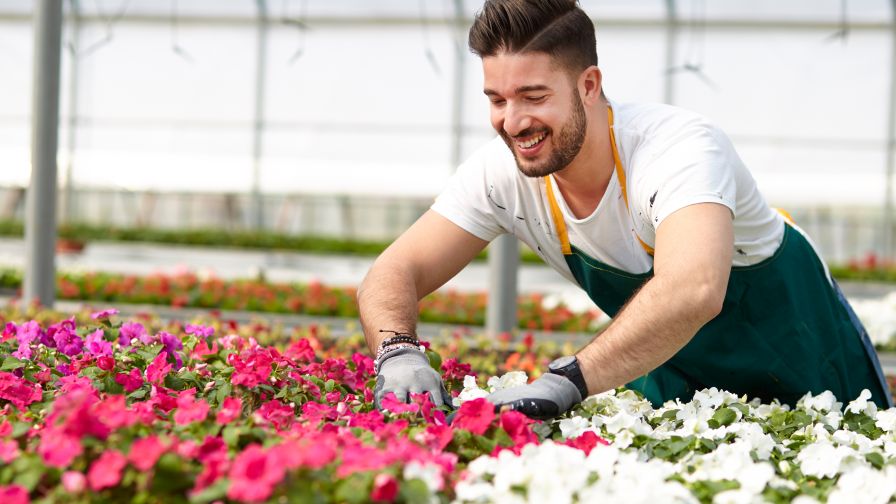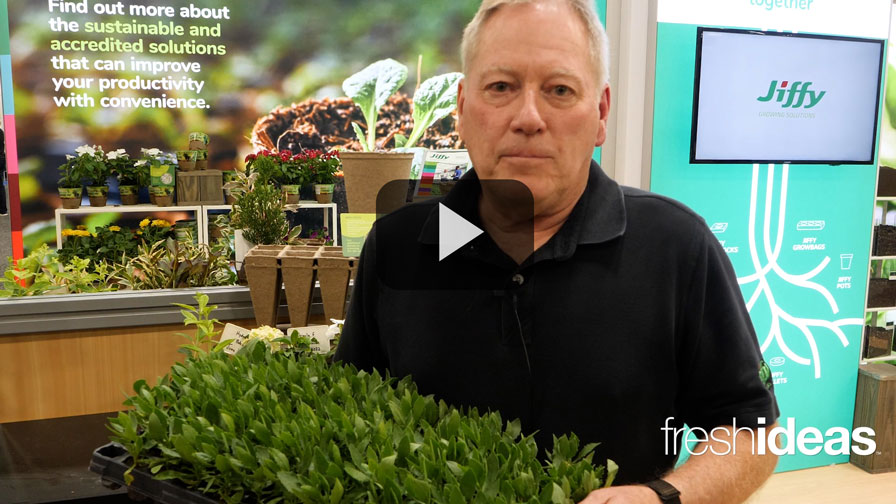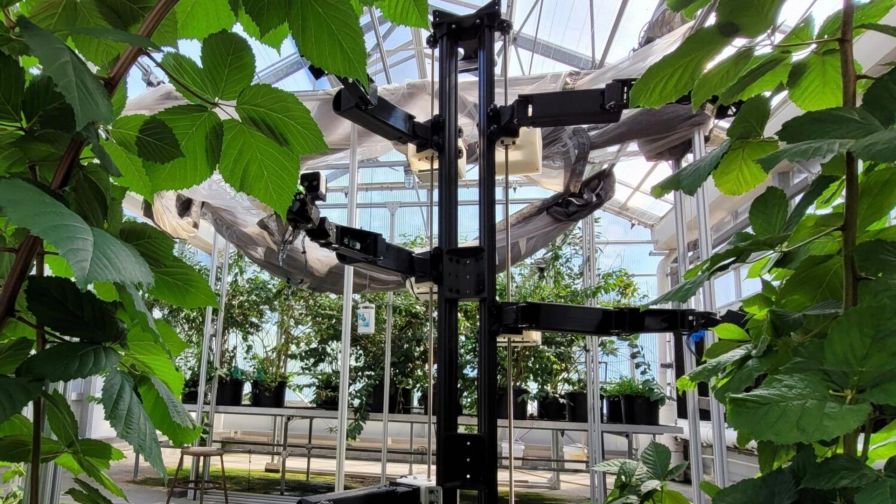Optimizing Your Greenhouse for Biostimulant Application Efficiency
Editor’s note: This is the final part a three-part series on the efficacy of biostimulants in the greenhouse. Special thanks to Ohio State’s Michelle Jones for compiling the information from a panel she led at Cultivate’21. You can find Part 1 here, and Part 2 here.
Biostimulants are designed to enhance or benefit nutrient uptake, nutrient efficiency, tolerance to abiotic stress, crop quality, and yield in plants. So how can growers make sure their greenhouse is optimized to make the best use of these materials?
Dr. Michelle Jones, The Ohio State University DC Kiplinger Floriculture Chair, and a panel of industry experts addressed this and other questions during a discussion at Cultivate’21. The panel included Mark Freeman (Bioworks), Matthew Krause (Lallemand Plant Care), Troy Buechel (Premier Tech), and Blair Busenbark (Mycorrhizal Applications).
Keep reading for highlights from the discussion.
What are the beneficial plant responses to colonization with mycorrhizae and how long does it take to observe these responses?
Krause: Depending on the plant type, time in production, stage of growth, and growing conditions as well as type of mycorrhizal active ingredient(s) and nutrient status of the growing medium or soil, positive responses range from improved plant vigor to increased rooting density to greater resistance to drought stress to increased phosphorus or micronutrient content in the foliage. How long it takes to observe such responses depends on the plant type, variety, and growth stage, and the mycorrhizal product’s active ingredient(s), formulation, and application timing.
Busenbark: The plant relationship with mycorrhizal fungi is driven by the plant. The plant does not benefit from this relationship unless there is something that the mycorrhizal fungi can provide that the plant cannot get without this association. Improved nutrient availability, efficiency, and uptake is the most documented benefit, which results in increased phosphorus, nitrogen, potassium, sulfur, and micronutrients content in the plant.
The plant provides carbon to the mycorrhizal fungi in exchange for nutrients, water, and other compounds that are beneficial to the plant. Under stressful conditions, that it would without the mycorrhizae, and this mitigates the plant’s response to stress. When growing under stressful conditions, the mycorrhizal fungi search the soil to find water and nutrients to keep the plant healthy and productive in exchange for the needed carbon.
Mycorrhizal fungi have the ability to survive in soils that would be otherwise toxic to plants. This includes heavy metal and sodium-containing soils that are at levels that the plant cannot survive and/or be productive in by itself. Mycorrhizal fungi have the ability to acquire nutrients and water in these conditions and then transport nutrients and water to the plant through the hyphal network safely. The hyphal network provides this filtration and transportation which allows the plant to be productive under conditions that would otherwise be non-habitable.
The general time frame on association formation, functionality, and visual benefit measurements varies depending on the plant’s needs and the growing environment. The association, once developed, can start to provide benefits to the plant within 10 to 28 days. The visual benefit can develop sooner than 30 days; however, in most controlled environment growing systems, it is more often in the 45- to 60-day range.
Beuchel: Plants benefit from endomycorrhizal fungi through increased nutrient uptake, improved plant growth, increased flowering, drought tolerance, and mitigation of excess uptake of heavy metals from contaminated soils. These benefits are more pronounced where these stresses are more significant. Typically, it takes from two to four weeks for endomycorrhizae to completely colonize plant roots and for benefits to occur, depending on plant species. However, if the growing medium temperature is below 50 to 55°F or endomycorrhizal fungi inoculum levels are low in the growing medium, then colonization will take longer.
With this lag time, is the greatest benefit of using mycorrhizae going to be observed during production or by the final consumer?
Krause: This also largely depends on the plant’s type and variety, growth stage, and time in production. Generally, plants in production less than three to four weeks that have been treated with mycorrhizae at seeding or transplant will not exhibit the possible benefits during this period, but the effects can be observed in the next level of production or by the end consumer. For woody crops, results can typically be observed after the first or second season of production in the field, depending on the product, the plant species and variety, and soil and environmental conditions.
Busenbark: This depends on the growing system of both the production cycle and the consumer. The challenge from a production system is the nutrition levels used and the time that the grower has this plant in their possession. There are plants that will benefit faster, and there are growing systems that will realize the benefit before that grower moves the plant material to the next level. It is a given that the final consumer will realize the benefit in almost all situations. The grower can realize the benefits through the different stages of production, and that level of benefit will be determined by the production system, plant material, environment, and time. The grower can even benefit once it leaves the production system. As it goes to a retailer or big box store, the plant has a higher level of survivability when it is grown with mycorrhizal fungi. The use of mycorrhizae also provides an insurance for the grower as the plant moves from grower to retailer to the home garden since the plant will be of higher quality and better able to survive once transplanted.
Beuchel: Although most growers will see some benefit from using mycorrhizal fungi, consumers often see greater benefits, for two reasons. First, when growers use endomycorrhizae, the plant roots will be already colonized before the consumer buys the plant. Second, homeowners get a better performing plant that can tolerate stresses in a low-care environment, since some consumers may not adequately care for the needs of the plant.
How many strains of mycorrhizae are available? Are they compatible with other biological products? How is this tested and where can these recommendations be found?
Freeman: BioWorks (www.bioworksinc.com has ongoing compatibility studies which include plate testing of other biological products with RootShield Plus. In-vivo studies have shown that RootShield Plus and mycorrhizae can co-exist on plant roots and will promote plant health. Trichoderma harzianum is a fast-growing and aggressive root colonizer which, combined with the production of anti-microbial metabolites, will inhibit root colonization by certain fungi. However, research has shown that bicontrol strains (with biostimulant properties) like T. harzianum can actually promote the activity of nonpathogenic bacteria and mycorrhizal fungi. There is always room for more work using modern genomic tools to examine these dynamics in real time, but so far the relationship between these beneficial fungi looks to be a friendly one.
Busenbark: There are roughly 400 arbuscular mycorrhizal fungi species and 5,000 ectomycorrhizal fungi species that have been identified thus far. Ectomycorrhizal fungi are a lot more plant specific as this group of fungi associate, with about 10% of the world’s plants which are conifers, select hardwood trees, and some tree nuts. Arbuscular mycorrhizal fungi (AMF) associate with about 80% of the world’s plants (including most greenhouse plants), which illustrates that they are more generalists. As a reminder, in these associations between plant and mycorrhizal fungi, the plant is regulating the association which includes turning on and off the association as well as how many associations that the plant maintains with different species of mycorrhizal fungi. For Arbuscular mycorrhizal fungi, they can form associations with many different types of plants. For these AMF-associated plants, they can form associations with many different AMF fungi based on their needs and benefits with that associations.
There is a difference between what is observed in nature and what is provided in a commercial inoculant. In most commercial offerings of mycorrhizal fungi, especially Arbuscular mycorrhizal fungi, there is one species per product. This is based on commercial limitations and an indication of the difficulty of commercial Arbuscular mycorrhizal fungi production. The plant growing systems create a range of variables that affect plant productivity, and these conditions change during a growing cycle as well as between growing cycles. When selecting a commercial inoculant, it is best to provide a technology that provides the most benefit across a wide range of environments, growing systems, and plants. No one can predict the exact needs a plant will have, so providing a greater range of potential benefits through a broader selection of species provides a wider range of insurance that the plant will be productive no matter what stress they encounter.
Do all plants benefit from associations with mycorrhizae?
Krause: There are plant families that are known not to form associations with any of the four types of mycorrhizae. It is best to consult with the manufacturers or distributors to determine which mycorrhizae products are most suited to your various plant families.
It is also important to note that the most beneficial plant-mycorrhizae associations to the plant occur in dense, highly mineralized soils that cannot support natural microbial communities that can solubilize fixed phosphorus and iron as well as limit plant root exploration and distribution. Mycorrhizal associations are generally not as beneficial to the plant when soluble phosphorus and micronutrients are readily available to the plant through constant liquid feed or optimized controlled-release fertilizer programs.
Busenbark: There are well-defined lists of plants that include which mycorrhizae they associate with, or if they have lost their genetic ability to form an association with mycorrhizal fungi
Beuchel: Not all greenhouse crops form associations with endomycorrhizal fungi; however, endomycorrhizae do not harm these plants. Some plants that are not colonized and therefore show no benefits include:
- Annuals: Dianthus, lobularia, orchids, stocks
- Edibles: Cole crops (broccoli, cabbage, cauliflower, kale, mustard, radish), beat, spinach, swiss chard, blueberries
- Perennials: alyssum, aubrieta, azalea, dianthus, gypsophila, iberis, lupine, lychnis, sedum, sermpervivums
There is a lot of different information out there about mycorrhizae propagules and spores. If you have trees out in the field and they have been treated with mycorrhizae, after they are dug, does the soil need to be reinoculated with mycorrhizae for the next crop? Do they have to be applied every year in trees? Trees goes dormant and the spore goes dormant so why would you need to re-inoculate every spring?
Busenbark: One application of mycorrhizae should be enough, and the population should increase over time. In some cases, reapplication is necessary during nursery production. When harvested as bare root trees, this may remove and trim roots which results in losses of mycorrhizae or disruption of the fungal hyphae and you may need to reapply to reestablish this network. It also depends on how the soil is managed.
Mycorrhizal fungi, arbuscular, and ectomycorrhizal fungi are usually with the plant for the life of the plant. There needs to be a recognized difference between commercial production and natural environments. In these natural environments, trees and plants are grown without a productivity component. In these natural conditions, nutrients and other influencers to these associations are less affecting, so there is this natural selection process for that environment. I think that it is different in production systems where optimizing productivity is the driver and includes production inputs that can influence the environment, growing system, plant productivity and microorganisms. These production influencers can require additional inoculations to maintain a level of productivity. Specifically, for multi-year plant production due to changes through the entire production cycle, the requirement changes over the multiple year process, each of the tree species requires different benefits from these mycorrhizal fungi associations. These multi-year plants can benefit from annual inoculations to continue to provide species that are beneficial across different production system conditions. Without these annual inoculations, there could be a production system selection that reduces the ability to achieve the targeted optimized growing system. Early spring annual inoculations in the early stages of development will be the most beneficial. Depending on the tree and production system, inoculations later in the production cycle beyond five to 10 years can still benefit; however, these are probably less frequent as the tree establishment and needs will be less variable.
Perennial plants go through different stages in their life cycle, typically a vegetative stage and then a reproductive stage. During the reproductive stage plants produce flowers, seeds, and fruit in most cases. For plants focused on shoot and leaf growth a different set of nutrients is needed (mostly nitrogen, calcium, magnesium, etc.) than do those plants that are in their reproductive stage (lots of phosphorus). Some species of mycorrhizal fungi are better than others in providing specific benefits to the host plant, for instance nutrient uptake. One species might be more effective in nitrogen uptake, but others are better for phosphorus uptake. While it is true that mycorrhizal association lasts for the life of the plant, the community composition of mycorrhizal fungi changes over time. Therefore, it doesn’t make much sense to reinoculate perennial plants with the same single species every year, but it might be beneficial to do the reinoculation with multiple species. If an inoculant product contains multiple species, that doesn’t necessarily mean that after the first inoculation all species established symbiosis on the roots, but likely only those that the plants needed at the time of inoculation. Since nutritional needs and the composition of root exudates change over time with the plant growth stages, at the time of reinoculation, say one year later, plants might need other species to form symbiosis with. At this point, this is a speculation and needs solid research data to back up these assumptions.
Beuchel: Perennials and trees go dormant over the winter months and if they are colonized by mycorrhizal fungi, the fungi also go dormant. Prior to dormancy, mycorrhizae produce spores that persist in the soil through the winter, while most of the vegetative phase of the fungus dies. Once the plant comes out of dormancy in the spring, its roots leak carbon rich exudates that trigger mycorrhizae spores that are near the root to germinate and then recolonize the roots. However, colonization may be sparse so reinoculation can be beneficial.
In the case of annual crops, such as flowers and vegetables, field and landscape soils are often disturbed or plowed which detrimentally affects mycorrhizal populations in the soil. When new plants are introduced into the soil, they should be treated with mycorrhizal fungi prior to planting as mycorrhizal spores that persisted in the soil may not be near the roots of newly transplanted plants. However, after several years of repeating this cycle, we have seen field and landscapes become sufficiently colonized by mycorrhizal fungi that transplants without mycorrhizae can become colonized within three to six weeks.











